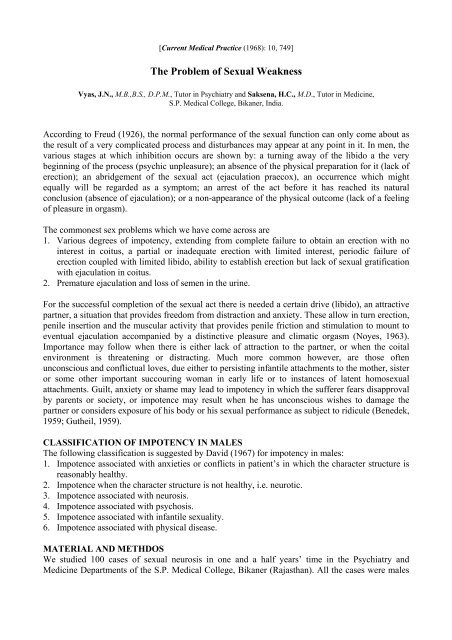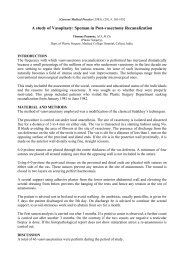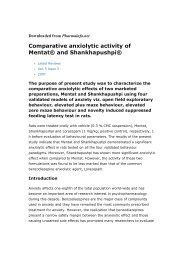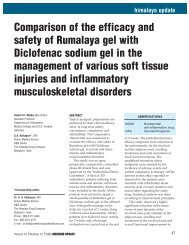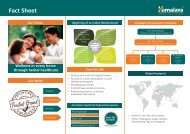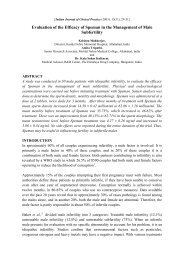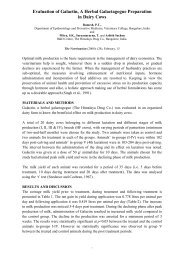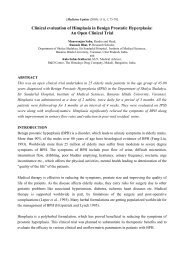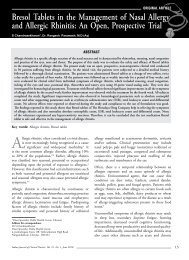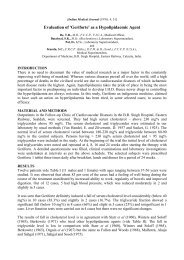The problem of sexual weakness - Himalaya Drug Company
The problem of sexual weakness - Himalaya Drug Company
The problem of sexual weakness - Himalaya Drug Company
Create successful ePaper yourself
Turn your PDF publications into a flip-book with our unique Google optimized e-Paper software.
[Current Medical Practice (1968): 10, 749]<br />
<strong>The</strong> Problem <strong>of</strong> Sexual Weakness<br />
Vyas, J.N., M.B.,B.S., D.P.M., Tutor in Psychiatry and Saksena, H.C., M.D., Tutor in Medicine,<br />
S.P. Medical College, Bikaner, India.<br />
According to Freud (1926), the normal performance <strong>of</strong> the <strong>sexual</strong> function can only come about as<br />
the result <strong>of</strong> a very complicated process and disturbances may appear at any point in it. In men, the<br />
various stages at which inhibition occurs are shown by: a turning away <strong>of</strong> the libido a the very<br />
beginning <strong>of</strong> the process (psychic unpleasure); an absence <strong>of</strong> the physical preparation for it (lack <strong>of</strong><br />
erection); an abridgement <strong>of</strong> the <strong>sexual</strong> act (ejaculation praecox), an occurrence which might<br />
equally will be regarded as a symptom; an arrest <strong>of</strong> the act before it has reached its natural<br />
conclusion (absence <strong>of</strong> ejaculation); or a non-appearance <strong>of</strong> the physical outcome (lack <strong>of</strong> a feeling<br />
<strong>of</strong> pleasure in orgasm).<br />
<strong>The</strong> commonest sex <strong>problem</strong>s which we have come across are<br />
1. Various degrees <strong>of</strong> impotency, extending from complete failure to obtain an erection with no<br />
interest in coitus, a partial or inadequate erection with limited interest, periodic failure <strong>of</strong><br />
erection coupled with limited libido, ability to establish erection but lack <strong>of</strong> <strong>sexual</strong> gratification<br />
with ejaculation in coitus.<br />
2. Premature ejaculation and loss <strong>of</strong> semen in the urine.<br />
For the successful completion <strong>of</strong> the <strong>sexual</strong> act there is needed a certain drive (libido), an attractive<br />
partner, a situation that provides freedom from distraction and anxiety. <strong>The</strong>se allow in turn erection,<br />
penile insertion and the muscular activity that provides penile friction and stimulation to mount to<br />
eventual ejaculation accompanied by a distinctive pleasure and climatic orgasm (Noyes, 1963).<br />
Importance may follow when there is either lack <strong>of</strong> attraction to the partner, or when the coital<br />
environment is threatening or distracting. Much more common however, are those <strong>of</strong>ten<br />
unconscious and conflictual loves, due either to persisting infantile attachments to the mother, sister<br />
or some other important succouring woman in early life or to instances <strong>of</strong> latent homo<strong>sexual</strong><br />
attachments. Guilt, anxiety or shame may lead to impotency in which the sufferer fears disapproval<br />
by parents or society, or impotence may result when he has unconscious wishes to damage the<br />
partner or considers exposure <strong>of</strong> his body or his <strong>sexual</strong> performance as subject to ridicule (Benedek,<br />
1959; Gutheil, 1959).<br />
CLASSIFICATION OF IMPOTENCY IN MALES<br />
<strong>The</strong> following classification is suggested by David (1967) for impotency in males:<br />
1. Impotence associated with anxieties or conflicts in patient’s in which the character structure is<br />
reasonably healthy.<br />
2. Impotence when the character structure is not healthy, i.e. neurotic.<br />
3. Impotence associated with neurosis.<br />
4. Impotence associated with psychosis.<br />
5. Impotence associated with infantile <strong>sexual</strong>ity.<br />
6. Impotence associated with physical disease.<br />
MATERIAL AND METHDOS<br />
We studied 100 cases <strong>of</strong> <strong>sexual</strong> neurosis in one and a half years’ time in the Psychiatry and<br />
Medicine Departments <strong>of</strong> the S.P. Medical College, Bikaner (Rajasthan). All the cases were males
and their ages varied between 16 and 55 years. <strong>The</strong> maximum age incidence was found between 21<br />
and 25 years (Table I).<br />
Table 1: Age incidence<br />
Sl.<br />
No.<br />
Age Group<br />
(in years)<br />
No. <strong>of</strong> Cases<br />
1 16 to 20 24<br />
2 21 to 25 38<br />
3 26 to 30 19<br />
4 31 to 35 8<br />
5 36 to 40 5<br />
6 41 to 45 3<br />
7 46 to 50 2<br />
8 51 to 55 1<br />
Total cases 100<br />
Majority <strong>of</strong> the cases (80%) belonged to the villages, and 20% came from urban areas. About 55%<br />
cases complained <strong>of</strong> <strong>sexual</strong> impotence and the remaining 45% cases came with complaints <strong>of</strong><br />
premature ejaculation, night discharges and passing semen in the urine. In all the cases we used<br />
mainly two drugs <strong>of</strong> ‘<strong>Himalaya</strong> <strong>Drug</strong> Co.’, i.e.<br />
i) Tentex forte which contains Musk, Saffron, Yohimbine hydrochloride, purified Nox<br />
vomica, Makardhwaj, Shilajeet, Orchis mascula, Anacyclus pyrethrum, Withania somnifera,<br />
Sida cordifolia, Bombax malabaricum, Argyreia, speciosa, Mucuna pruriens and<br />
Swarnamakshik chasma, and<br />
ii) Speman forte which contains Orchis mascula, Lactuca scariola, Hygrophila spinosa,<br />
Mucuna pruriens, extracts <strong>of</strong> Parmelia parlata, Argyreia speciosa, Tribulus terrestris and<br />
Leptadenia reticulata, Suvarnavang, and Rauvolfia serpentina.<br />
We studied the efficacy and usefulness <strong>of</strong> these two non-hormonal preparations. We have not done<br />
any comparative study with placebos. We have given Tentex forte tablet in cases <strong>of</strong> <strong>sexual</strong><br />
impotence <strong>of</strong> various degrees. We prescribed 1 tablet morning and evening with milk or tea,<br />
normally up to a total <strong>of</strong> 90 tablets. Sexual abstinence was strongly advised for the first 20 days. In<br />
some cases we have given up to 120 tablets. After the resumption <strong>of</strong> <strong>sexual</strong> activity, we advised<br />
intercourse twice a week.<br />
In cases <strong>of</strong> premature ejaculation and passing semen in the urine, especially in the morning along<br />
with defaecation, Speman forte (<strong>Himalaya</strong> <strong>Drug</strong> Co.) was prescribed in doses <strong>of</strong> 2 tablets twice a<br />
day half an hour before meals for up to 6 weeks and abstinence was advised for 2 weeks.<br />
OBSERVATIONS AND RESULTS<br />
During these one and a half years we observed that the majority <strong>of</strong> patients came with physical<br />
complaints. <strong>The</strong>ir commonest complaints were pain in the abdomen, backache, palpitation, pain in<br />
the limbs, feeling <strong>of</strong> dullness, <strong>weakness</strong>, lack <strong>of</strong> appetite, gas formation, constipation and mild<br />
insomnia. Most <strong>of</strong> these patients had been taking medicines like B-complex, enzymes, analgesics<br />
etc., from the medical out-door without much relief. <strong>The</strong> majority (80%) <strong>of</strong> cases were referred<br />
from the medical out-patient department <strong>of</strong> P.B.M. Hospital, Bikaner to the psychiatry department<br />
<strong>of</strong> this hospital with the diagnosis <strong>of</strong> neurosis. While interviewing these patients in detail, we found<br />
that the root cause <strong>of</strong> their trouble was <strong>sexual</strong> <strong>weakness</strong>. A few patients (20%) came with a<br />
secondary depression due to their <strong>sexual</strong> <strong>weakness</strong>.<br />
<strong>The</strong> results were quite good and encouraging with these two drugs. Along with supportive<br />
psychotherapy like persuasion and discussion to restore self-confidence, we noted that about 85%<br />
<strong>of</strong> the patients got relief from their neurotic symptoms and became confident <strong>of</strong> their <strong>sexual</strong> power.
<strong>The</strong>y also became free from the anxiety and secondary depression. In 15% <strong>of</strong> the cases, our results<br />
were not very encouraging because <strong>of</strong> their basic neurotic personality.<br />
DISCUSSION<br />
Sexual <strong>weakness</strong> is one <strong>of</strong> the commonest <strong>problem</strong>s among young persons now-a-days. But due to<br />
their lack <strong>of</strong> knowledge and education, they will not consult a doctor in the beginning and they will<br />
come with some physical illness or with secondary depression. In men, impotence and premature<br />
ejaculation are the commonest psychosomatic symptoms. So, one must go into details to find out<br />
the emotional <strong>problem</strong> in every case. One must take a careful history that will determine the<br />
situations in which failure at intercourse has occurred. Particular attention should be paid to the<br />
attitude towards the partner, the environment <strong>of</strong> the coital acts, the frequency <strong>of</strong> <strong>sexual</strong> relations,<br />
attitudes toward and desires for various forms <strong>of</strong> precoital stimulation and study <strong>of</strong> the attitude <strong>of</strong><br />
the partner, which is most significant. Impotency due to such illnesses as multiple sclerosis,<br />
syphilis, diabetes, or other disorders involving the sacral segments <strong>of</strong> the spinal cord, the lumbar<br />
parasympathetic outflow, or the lumbar sympathetic chain should be excluded by general medical<br />
and neurological examinations. A general check up must be followed by a minute inspection <strong>of</strong> the<br />
penis, palpation <strong>of</strong> the tests and recital examination <strong>of</strong> the prostate with a view to remove doubts<br />
about the condition <strong>of</strong> the genitalia and their adenexas (Heilig, 1968).<br />
Sometimes, impotence may be the early sign <strong>of</strong> a serious mental illness such as general paresis or<br />
other organic psychosis. <strong>The</strong>y are regularly found in morphinism and severe alcoholism. In<br />
endogenous depression, libido and potency are reduced or abolished and this may also occur in<br />
Schizophrenia (Mayor Gross, 1962).<br />
CONCLUSION<br />
In conclusion it may be said that the <strong>problem</strong> <strong>of</strong> male <strong>sexual</strong> <strong>weakness</strong> has many facets. Most <strong>of</strong> the<br />
patients get unduly frightened because <strong>of</strong> the lack <strong>of</strong> sex education and wrong advice given by their<br />
friends and quacks, to whom they disclose their secrets in the beginning. In the present study we<br />
found that while Tentex forte tablets are effective in increasing <strong>sexual</strong> desire and improving<br />
performance, tablets <strong>of</strong> Speman forte relieve the symptoms <strong>of</strong> premature ejaculation and noctural<br />
emissions. One should also find out the psychological factors for the disturbances <strong>of</strong> various <strong>sexual</strong><br />
<strong>problem</strong>s. Along with these drugs, one must give some supportive psychotherapy to restore the self<br />
confidence <strong>of</strong> the patient. Our results are based purely on the subjective response <strong>of</strong> the patients.<br />
In the end it may be said that Tentex forte is strongly recommended for all cases <strong>of</strong> <strong>sexual</strong><br />
deficiency and Speman forte for over active <strong>sexual</strong> centres. which produce premature ejaculation,<br />
nocturnal emissions and spermatorrhoea.<br />
REFERENCES<br />
1. Arthur, P. Noyes, Modern Clinical Psychiatry; P.403, 1963, W.B. Saunders <strong>Company</strong>,<br />
Philadelphia, and London.<br />
2. Benedek, T.F.; American Handbook <strong>of</strong> Psychiatry, Vol. 1, P. 727-748. New York Basic Book<br />
Inc., 1959.<br />
3. David Bland; <strong>The</strong> Practitioner, 198: 598; 1967.<br />
4. Gutheil, E.; American Handbook <strong>of</strong> Psychiatry, Vol. 1, P. 708-726, New York Basic Books<br />
Inc., 1959.<br />
5. Heilig, R.; Probe, 7:49; 1968.<br />
6. Mayer Gross; Clinical Psychiatry, P. 182, 1962.


